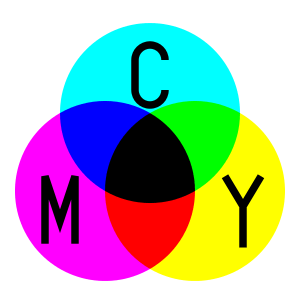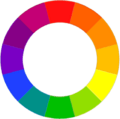Subtractive color facts for kids
Subtractive color is a way to understand how colors mix when you use paints, inks, or dyes. It's about what happens when light hits a surface that has color on it.
Imagine white light, which contains all colors, shining on a painted surface. The paint or ink absorbs some colors of light and reflects others. The colors that are reflected are the ones we see. This is how color printing and photography work.
Contents
How CMY Colors Work in Printing
In color printing, the main colors used are cyan, magenta, and yellow. We often call this the CMY model.
- Cyan is like a filter that stops red light. When you put cyan ink on white paper, it absorbs the red part of the white light. The paper then reflects blue and green light back to your eyes.
- Magenta is a filter that stops green light. It absorbs green, reflecting red and blue.
- Yellow is a filter that stops blue light. It absorbs blue, reflecting red and green.
By mixing different amounts of these three colors, printers can create almost any color you can imagine.
CMYK Printing for Better Blacks
In modern inkjet printing and large-scale mass production printing, a fourth color is added. This is black ink, called "K" for "Key" (or sometimes "Black"). This system is known as the CMYK color model. Adding black helps to create deeper, richer black colors and sharper text. It also makes printing more efficient.
RYB: Colors for Artists
RYB stands for red, yellow, and blue. This is an older set of subtractive primary colors. Artists, especially painters, have used the RYB model for a long time to mix their pigments.
In the RYB color "wheel", red, yellow, and blue are the primary colors. When you mix these primary colors, you get secondary colors:
These secondary colors are orange, green, and violet (VOG).
Related Pages
- Additive color
- Color model
- Color theory
- Primary color
- Stanford University CS 178 interactive Flash demo comparing additive and subtractive color mixing.
Images for kids
See also
 In Spanish: S%C3%ADntesis sustractiva de color para ni%C3%B1os
In Spanish: S%C3%ADntesis sustractiva de color para ni%C3%B1os





